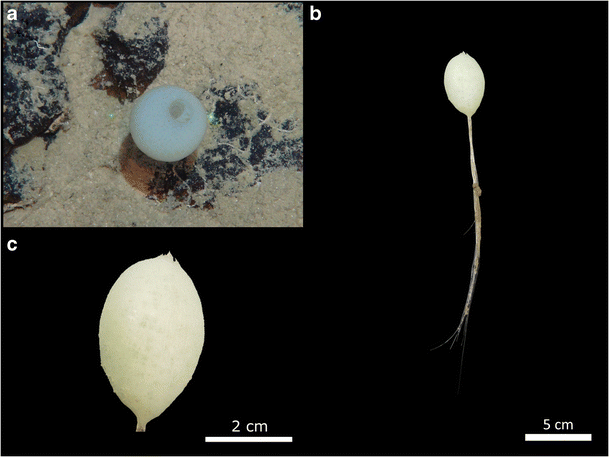The last half year saw a slate of great studies highlighting the diversity, distribution, and resilience (or lack thereof) of the animals that live in polymetallic nodule fields. While there are many, many more, we have selected a cross-section of the more unusual and unexpected findings.
Sponges
Sponges, particularly glass sponges, may prove to be one of the most important bio-indicators for assessing the impact of nodule extraction. Glass sponges, which need hard substrate, can grow directly on polymetallic nodules. These slow-growing animals are among the most abundant benthic macrofauna at polymetallic nodule fields. It could take decades to centuries for glass sponges to recover from mining impacts. Understanding the ecology and distribution of these animals is an important component of environmental assessment at nodule fields.
A series of recent studies in the CCZ seeks to advance our understanding of deep-sea glass sponges. Preliminary papers have examined their diversity and distribution across the seafloor and are beginning to tease apart their evolutionary relationships and population structure. From the first field study of glass sponges at deep-sea nodule fields, nine species were identified, three of which were new to science.
- Kersken et al. (2018) Deep-sea glass sponges (Hexactinellida) from polymetallic nodule fields in the Clarion-Clipperton Fracture Zone (CCFZ), northeastern Pacific: Part I – Amphidiscophora. DOI: 10.1007/s12526-017-0805-1.
- Kersken et al. (2018) First insights into the phylogeny of deep-sea glass sponges (Hexactinellida) from polymetallic nodule fields in the Clarion-Clipperton Fracture Zone (CCFZ), northeastern Pacific. DOI: 10.1007/s10750-017-3498-3.
Nematodes
Nematodes are another important, yet relatively understudied, group of animals that play a critical role in the health of deep-sea ecosystems. These round-worms live within deep-sea sediments throughout the ocean. Quantifying the abundance, diversity, and distribution of nematodes within a nodule field and how these compare to the background fauna is essential to fully assess the environmental impacts of a mining regime.
One of the big unknowns in nematode distribution with respect to deep-sea mining is how unique the assemblages are within nodule fields. A recent study from the Indian Ocean seeks to clarify this question while quantifying the baseline distribution of nematodes across the Central Indian Ocean Basin. The preliminary results are still inconclusive but suggest that some nematode morphotypes are found exclusively in the crevices of polymetallic nodules.
- Singh et al. (2018) The community structure of the deep-sea nematode community associated with polymetallic nodules in the Central Indian Ocean Basin. DOI: 10.1016/j.dsr2.2018.07.009.
Monoplacophorans
Monoplacophorans are the oddballs of the molluscan kingdom. These limpet-shaped animals have a single shell, no apparent head, and repeating segments of organ and muscle arranged in a curve along either edge of their foot. Previously known only from fossils, the discovery of a living monoplacophoran in the deep sea was considered one of the most important zoological discoveries of the 20th century. Monoplacophorans represent a distinct taxonomic lineage and are critical to understanding the evolution of deep-sea animals. There are 35 known living species of monoplacophoran. They are predominantly found within polymetallic nodule fields.
During a recent Okeanos Explorer cruise, extensive monoplacophoran trails were observed on the ferromanganese crust of two volcanic seamounts near American Samoa. Two individual monoplacophorans were seen grazing on the ferromanganese substrate. Monoplacophorans are rarely observed alive. These are the first observations of a living monoplacophoran underwater and the deepest observation on record. Living specimens, when identified, are most often found attached to polymetallic nodules during geologic sampling.
- Sigwart et al. (2018) Deep-sea video technology tracks a monoplacophoran to the end of its trail (Mollusca, Tryblidia). DOI: 10.1007/s12526-018-0860-2.
Impact Studies
Experimental studies of deep-sea mining’s impact on the sea floor are few and far between. In 1989, a plow harrow was dragged across a small swatch of the Peru Basin to simulate the possible impacts of nodule mining. The Disturbance and Recolonization (DISCOL) experiment was last revisited in 2015, and results from this 26-year study are slowly emerging.
For sea cucumbers commonly found at these nodule fields, species densities and assemblages in the ploughed furrow appeared similar to those documented at reference sites, suggesting that recovery on this multi-decadal time scale was possible. However, when looking at biomass, carbon stock within the plow tracks were half that of the reference sites. This suggests that, even for a small disturbance site, recovery times are greater than a quarter-century.
- Stratmann et al. (2018) Abyssal plain faunal carbon flows remain depressed 26 years after a simulated deep-sea mining disturbance. DOI: 10.5194/bg-15-4131-2018.
- Stratmann et al. (2018) Recovery of Holothuroidea population density, community composition, and respiration activity after a deep‐sea disturbance experiment. DOI: 10.1002/lno.10929.





